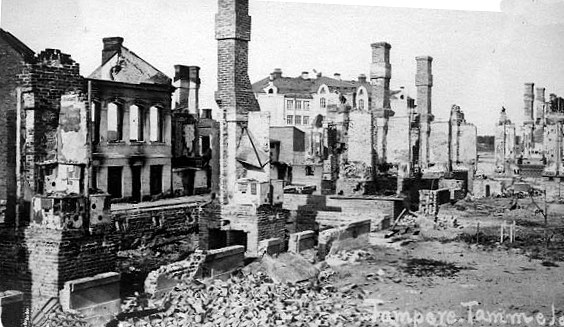
Battle of Tampere
The Battle of Tampere was a 1918 Finnish Civil War battle, fought in Tampere, Finland from 15 March to 6 April between the Whites and the Reds. It is the most famous and the heaviest of all the Finnish Civil War battles.[2][3] Today it is particularly remembered for its bloody aftermath as the Whites executed hundreds of capitulated Reds and took 11,000 prisoners who ended up in the Kalevankangas camp.[4]
Background[edit]
In the 1910s, Tampere was the third largest town in Finland with a population of approximately 60,000, including the suburbs. It was the most industrialized town in Finland which was considered the capital of the Finnish labour movement. Tampere had played a key role in the 1905 general strike and the town was a stronghold for the trade unions and the Social Democratic Party.[5]
As the Civil War started in late January 1918, the Reds targeted the important railway junction of Haapamäki, 100 kilometres north of Tampere. The frontline was soon established 50–60 kilometres north of Tampere and Tavastia Front became the major theatre of the war. The large working-class population and the railway connections made Tampere the main base for Red Guards, although the Red government was working in Helsinki. On January 27, Tampere was completely under the control of the Reds.[6] Tampere Red Guard had about 6,000 members, including 300 women, about 5% of the total.[5]
Aftermath[edit]
The Whites started the executions right after the Reds surrendered. Up to 1,000 were shot as well as all the Russians in Tampere. Most of the 200 executed Russians were soldiers. The executed included also women and children, although captured women fighters were not systematically shot like the Whites did in Lahti and Vyborg.[5] Even people who were neither involved in the battle nor members of the Red Guards were imprisoned and killed.[13]
As the number of capitulated became too large, it was impossible to shoot everyone. More than 10,000 Reds were gathered to the Central Square, where they had to stand for nearly 24 hours. The prisoners were then transferred to a prison camp established in the eastern Kaleva district. During the next five months, 1,228 Reds died in the Tampere camp of executions, disease or hunger.[5]
Memorials[edit]
The statue of the White Army commander C. G. E. Mannerheim stands at the site where he was observing the battle. The controversial statue was first suggested to the Koskipuisto park in 1939 but was finally erected on a hill eight kilometres from Tampere in 1956.[21] Due to its remote location, the statue has often been vandalized during the years by local anarchists and other left-wing radicals.[22] Vapaudenpatsas (The Statue of Liberty), by the sculptor Viktor Jansson, is another statue commemorating the White conquest of Tampere. It was placed in the Hämeenpuisto Park in 1921. The model of the figure was the far-right priest Elias Simojoki. The statue is holding a sword pointed towards the Tampere Workers' Hall on the other side of the park.[23] The statue is often called Rummin-Jussi, after the nickname of the infamous White executioner Johannes From, who was responsible for executing more than 70 Reds.[24] The Swedish Brigade commemorative plaque is placed near the Kalevankangas Cemetery. It is a work of the sculptor Gunnar Finne.[25]
The Red memorial was erected to the Kalevankangas Cemetery in 1941. It was designed by the sculptor Jussi Hietanen who was held at the Kalevankangas Prison Camp in 1918 at the age of 15. Another memorial is placed in Pispala where the last Reds surrendered.[26]